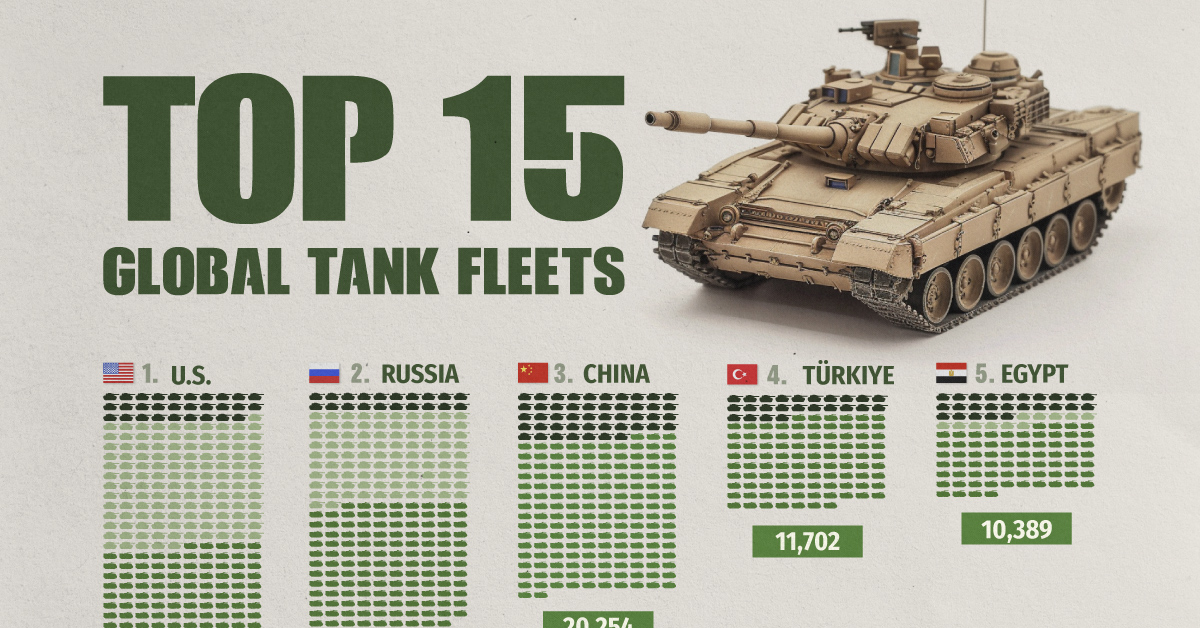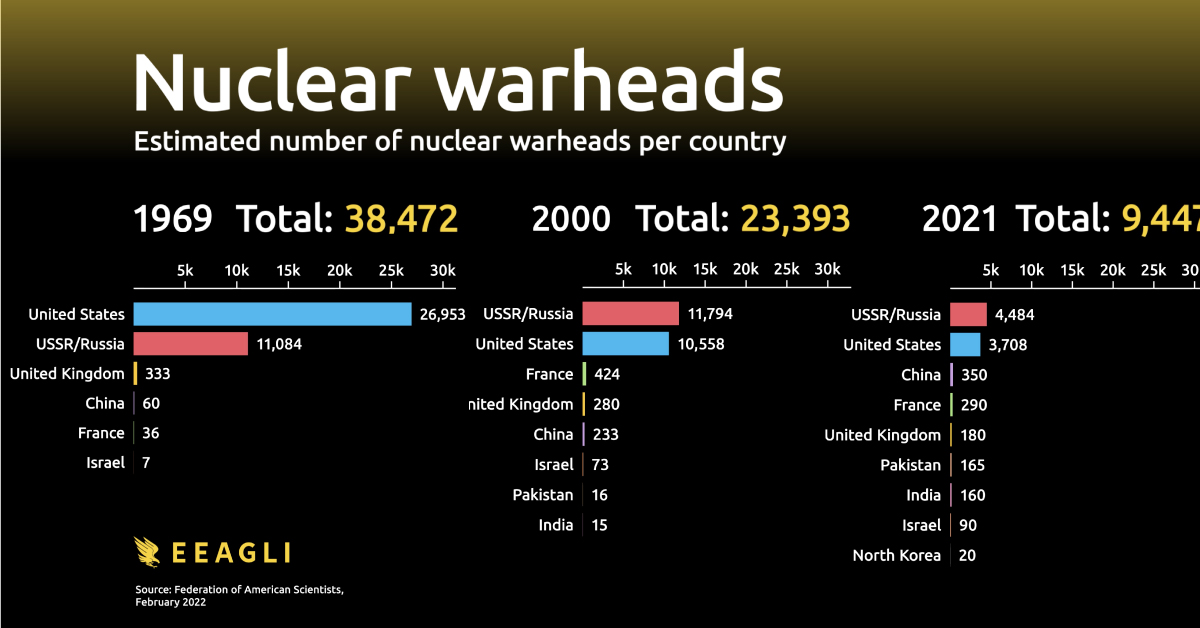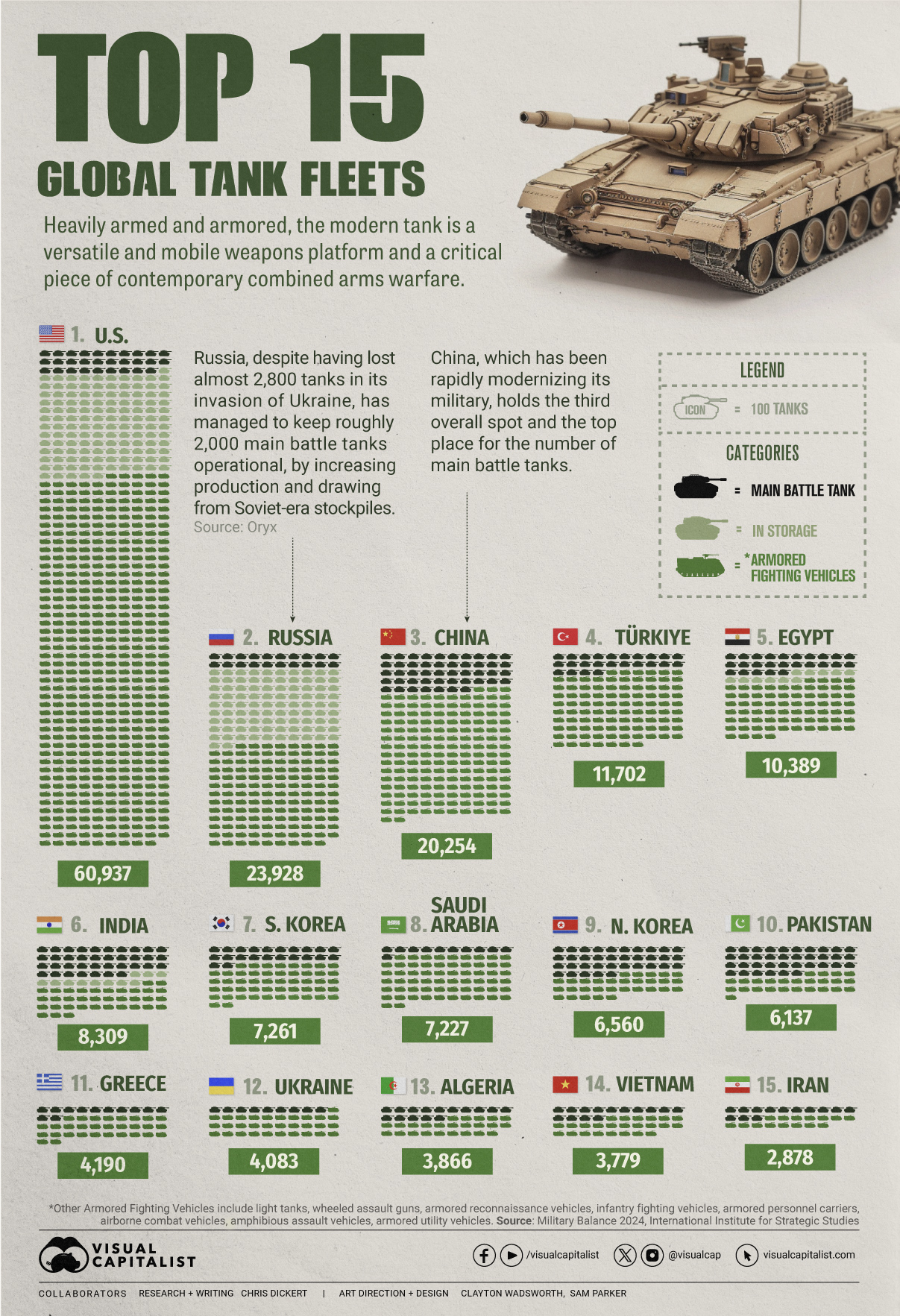War
Animated Chart: Nuclear Warheads by Country (1945-2022)
Visualizing The Nuclear Warheads of Countries Since 1945
Despite significant progress in reducing nuclear weapon arsenals since the Cold War, the world’s combined inventory of warheads remains at an uncomfortably high level.
Towards the late 1980s, the world reached its peak of stockpiled warheads, numbering over 64,000. In modern times, nine countries—the U.S., Russia, France, China, the UK, Pakistan, India, Israel, and North Korea—are estimated to possess roughly 12,700 nuclear warheads.
The animated chart above by creator James Eagle shows the military stockpile of nuclear warheads that each country has possessed since 1945.
Nuclear Warheads Currently in Possession by Countries
The signing of the Treaty on the Non-Proliferation of Nuclear Weapons (NPT) brought about a rapid disarmament of nuclear warheads. Though not immediately successful in stopping nuclear proliferation, it eventually led to countries retiring most of their nuclear arsenals.
As of 2022, about 12,700 nuclear warheads are still estimated to be in use, of which more than 9,400 are in military stockpiles for use by missiles, aircraft, ships and submarines.
Here’s a look at the nine nations that currently have nuclear warheads in their arsenal:
| Country | Military Stockpile | Retired Weapons | Total Inventory |
|---|---|---|---|
| 🇷🇺 Russia | 4,477 | 1,500 | 5,977 |
| 🇺🇸 United States | 3,708 | 1,720 | 5,428 |
| 🇫🇷 France | 290 | 0 | 290 |
| 🇨🇳 China | 350 | 0 | 350 |
| 🇬🇧 United Kingdom | 180 | 45 | 225 |
| 🇮🇱 Israel | 90 | 0 | 90 |
| 🇵🇰 Pakistan | 165 | 0 | 165 |
| 🇮🇳 India | 160 | 0 | 160 |
| 🇰🇵 North Korea | 20 | 0 | 20 |
| Total | 9,440 | 12,705 |
The U.S. and Russia are by far the two countries with the most nuclear warheads in military stockpiles, with each having close to 4,000 in possession.
Timeline: Key Events in the Nuclear Arms Race
At the dawn of the nuclear age, the U.S. hoped to maintain a monopoly on nuclear weapons, but the secret technology and methodology for building the atomic bomb soon spread. Only 10 countries have since possessed or deployed any nuclear weapons.
Here are a few key dates in the timeline of the nuclear arms race from 1945 to 2022:
August 6 & 9, 1945:
The U.S. drops two atomic bombs on Hiroshima and Nagasaki, Japan, decimating the cities and forcing the country’s surrender, ending the Second World War.
August 29, 1949:
The Soviet Union tests its first nuclear bomb, code-named First Lightning in Semipalatinsk, Kazakhstan. It becomes the second country to develop and successfully test a nuclear device.
October 3, 1952:
The UK conducts its first nuclear test at Montebello Islands off the coast of Western Australia, and later additional tests at Maralinga and Emu Fields in South Australia.
February 13, 1960:
France explodes its first atomic bomb in the Sahara Desert, with a yield of 60–70 kilotons. It moves further nuclear tests to the South Pacific, which continue up until 1996.
October 16–29, 1962:
A tense stand-off known as the Cuban Missile Crisis begins when the U.S. discovers Soviet missiles in Cuba. The U.S. intiaties a naval blockade of the island, with the crisis bringing the two superpowers to the brink of nuclear war.
October 16, 1964:
China becomes the fifth country to test an atomic bomb in 1964, code-named Project 596. The country would conduct an additional 45 atomic bomb tests at the Lop Nor testing site in Sinkiang Province through 1996.
July 1, 1968:
The NPT opens for signatures. Under the treaty, non-nuclear-weapon states agree to never acquire nuclear weapons, and nuclear powers must make a legal undertaking to disarm.
May 18, 1974:
India conducts an underground nuclear test at Pokhran in the Rajasthan desert, code-named the Smiling Buddha. Since conducting its first nuclear test, India has refused to sign the NPT or any subsequent treaties.
September 30, 1986:
Through the information provided by Israeli whistleblower and nuclear technician Mordechai Vanunu, The Sunday Times publishes a story that leads experts to conclude that Israel may have up to 200 nuclear weapons.
October 9, 2006:
After previously signing onto the NPT, North Korea breaks from the treaty and begins testing nuclear weapons in 2006. It has since gathered 20 nuclear warheads, though the actual number and their efficacy are unknown.
Though the threat of nuclear weapons never left, the latest growing tensions in Ukraine have brought the topic back into focus. Even as work towards disarmament continues, many of the top nuclear states hesitate to fully reduce their arsenals to zero.

This article was published as a part of Visual Capitalist's Creator Program, which features data-driven visuals from some of our favorite Creators around the world.
War
Visualized: Top 15 Global Tank Fleets
Heavily armed and armored, the modern tank is a versatile and mobile weapons platform, and a critical piece of contemporary warfare.

The Top 15 Global Tank Fleets
This was originally posted on our Voronoi app. Download the app for free on iOS or Android and discover incredible data-driven charts from a variety of trusted sources.
Heavily armed and armored, the modern tank is a versatile and mobile weapons platform, and a critical piece of contemporary warfare.
This visualization shows the top 15 global tank fleets, using data from the 2024 Military Balance report from the International Institute for Strategic Studies (IISS).
Let’s take an in-depth look at the top three fleets:
1. United States
As the world’s pre-eminent military power, it’s perhaps no surprise that the United States also has the largest tank fleet, by a wide margin.
In total, they have just over 45,000 armored fighting vehicles in operation, along with 2,640 main battle tanks (MBTs), and 12,800 vehicles in storage, of which 2,000 are main battle tanks.
| Category | Vehicles | Global rank |
|---|---|---|
| Main battle tanks | 2,640 | 4 |
| Armored reconnaissance | 1,745 | 1 |
| Infantry fighting vehicles | 3,262 | 3 |
| Armored personnel carriers | 10,644 | 1 |
| Amphibious assault vehicles | 1,401 | 1 |
| Armored utility vehicles | 28,445 | 1 |
| Storage | 12,800 | 1 |
| Total | 60,937 | 1 |
The U.S. is internalizing the lessons from the ongoing invasion of Ukraine, where Western-supplied anti-tank weapons and massed Ukrainian artillery have been cutting Russian tanks to pieces. As a result, the U.S. recently canceled an upgrade of the M1 Abrams in favor of a more ambitious upgrade.
Meanwhile, the U.S. is nervously eyeing a more confident China and a potential clash over Taiwan, where air and naval forces will be critical. However, a recent war game showed that Taiwanese mechanized ground forces, kitted out with American-made tanks and armored fighting vehicles, were critical in keeping the island autonomous.
2. Russia
According to Oryx, a Dutch open-source intelligence defense website, at time of writing, Russia has lost almost 2,800 main battle tanks since invading Ukraine. Considering that in the 2022 edition of the Military Balance, Russia was estimated to have 2,927 MBTs in operation, those are some hefty losses.
Russia has been able to maintain about 2,000 MBTs in the field, in part, by increasing domestic production. Many defense plants have been taken over by state-owned Rostec and now operate around the clock. Russia is also now spending a full third of their budget on defense, equivalent to about 7.5% of GDP.
At the same time, they’ve also been drawing down their Soviet-era stockpiles, which are modernized before being sent to the front. Just how long they can keep this up is an open question; their stockpiles are large, but not limitless. Here is what their storage levels look like:
| Category | 2023 | 2024 | YOY change |
|---|---|---|---|
| Main battle tanks | 5,000 | 4,000 | -20.0% |
| Armored reconnaissance | 1,000 | 100 | -90.0% |
| Infantry fighting vehicles | 4,000 | 2,800 | -30.0% |
| Armored personnel carriers | 6,000 | 2,300 | -61.7% |
| Total | 16,000 | 9,200 | -42.5% |
3. China
China holds the third overall spot and top place globally for the number of main battle tanks in operation. Untypically, the People’s Liberation Army has no armored vehicles in storage, which perhaps isn’t surprising when you consider that China has been rapidly modernizing its military and that stockpiles usually contain older models.
China also has one of the world’s largest fleets of armored fighting vehicles, second only to the United States. Breaking down that headline number, we can also see that they have the largest number of light tanks, wheeled guns, and infantry fighting vehicles.
| Category | Vehicles | Global rank |
|---|---|---|
| Main battle tanks | 4,700 | 1 |
| Light tanks | 1,330 | 1 |
| Wheeled guns | 1,250 | 1 |
| Infantry fighting vehicles | 8,200 | 1 |
| Armored personnel carriers | 3,604 | 5 |
| Airborne combat vehicles | 180 | 2 |
| Amphibious assault vehicles | 990 | 2 |
| Total | 20,254 | 3 |
This is equipment that would be integral if China were to make an attempt to reunify Taiwan with the mainland by force, where lightly armored mechanized units need to move with speed to occupy the island before Western allies can enter the fray. It’s worth noting that China also has one of the world’s largest fleets of amphibious assault vehicles.
End of the Tank?
Many commentators at the outset of Russia’s invasion of Ukraine, were quick to predict the end of the tank, however, to paraphrase Mark Twain, reports of the tank’s demise are greatly exaggerated.
With the U.S. and China both developing remote and autonomous armored vehicles, tanks could be quite different in the future, but there is nothing else that matches them for firepower, mobility, and survivability on the modern battlefield today.
-

 Markets1 week ago
Markets1 week agoU.S. Debt Interest Payments Reach $1 Trillion
-

 Markets2 weeks ago
Markets2 weeks agoRanked: The Most Valuable Housing Markets in America
-

 Money2 weeks ago
Money2 weeks agoWhich States Have the Highest Minimum Wage in America?
-

 AI2 weeks ago
AI2 weeks agoRanked: Semiconductor Companies by Industry Revenue Share
-

 Markets2 weeks ago
Markets2 weeks agoRanked: The World’s Top Flight Routes, by Revenue
-

 Countries2 weeks ago
Countries2 weeks agoPopulation Projections: The World’s 6 Largest Countries in 2075
-

 Markets2 weeks ago
Markets2 weeks agoThe Top 10 States by Real GDP Growth in 2023
-

 Money2 weeks ago
Money2 weeks agoThe Smallest Gender Wage Gaps in OECD Countries













